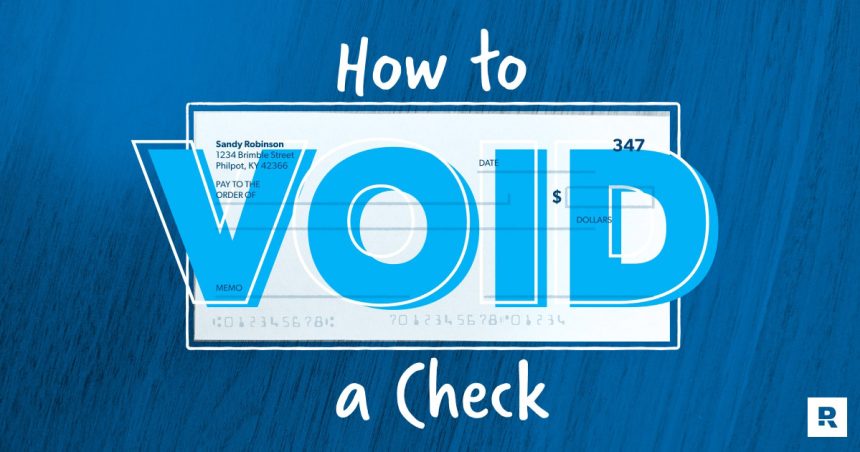Yes, it’s the digital age, but you still need to know how to void a check.
First off, void basically just means to cancel. So, a voided check has the word “VOID” literally written on it so it can’t be used for payment. Certain payroll companies or bills will ask for a voided check to set up your direct deposits or future payments. (See why it’s important?)
Now let’s talk about how to void a check, including when you’ll need to and what to do if you don’t have a physical checkbook.
How to Void a Check in 3 Steps
Step 1: Get a black or blue pen.
Step 2: Write “VOID” in large letters across the front of the check, big enough to cover any spot you’d normally write in information. Or you can write “VOID” five separate times—one in each section (date line, payee line, amount box, amount line and signature line).
If you’re handing over the voided check to set up direct deposits or automatic payments, leave the routing and account numbers at the bottom of the check visible. If you’re voiding the check because there was a mistake of any kind when you wrote it, cover up those bottom numbers. (We’ll cover this more in a minute!)
Step 3: Make a copy of the voided check for your records before you shred or give away the original.
Here’s a voided check example for you:
Yep, it’s really that easy!
Reasons for Voiding a Check
There are lots of reasons why you might need to void a check, but here are four super common ones:
- Setting up direct deposit: If you decide to get your paychecks through direct deposit (which can get that money in your bank account quicker than you making a trip to the bank to deposit a physical paycheck), your employer will probably ask you for a blank, voided check to set everything up.
- Setting up direct payments: On the flip side of direct deposit, if you’re an employer, you may need to void a blank check to set up electronic payments from your company to pay your employees or vendors.
- Starting regular bill or loan payments: It’s pretty common for a mortgage lender or other companies to ask you to submit a blank, voided check to set up automatic bill payments.
Remember, in all three of those cases, you need that routing and account number info clearly visible. Otherwise the companies won’t be able to get your money into or out of the right bank account!
Here’s another reason you might need to void a check:
- Canceling a check you don’t want to be cashed: What happens if you write a check and don’t want to use it? Maybe you wrote it for the wrong amount or to the wrong person, or you realize you don’t have enough money in your checking account to cover it.
No matter the reason for needing to trash a check, it’s a good idea to void it first just to be safe—yes, even if you’re planning to rip it up. And this is the example of when you should cover up the routing and account numbers at the bottom for even extra security!
How to Void a Check After Sending It to the Recipient
If you already sent a check that needs to be canceled, it’s obviously a little too late to write VOID across it. But not all hope is lost! There’s still a way to void a check after sending it—but you’ll have to act fast.
- Call your bank and ask them to cancel the check through a stop payment order—that blocks the check from being cashed. This is the quickest method! Just know that some banks actually charge a fee for this, so figure out how absolutely necessary it is.
- Request a stop payment order through your online bank account or app. Just be sure the online request will go through in time!
Heads up: You’ll need to give your bank specific information about the check, like who it’s going to, when it was dated, and the amount it was for. That’s one of the many reasons it’s always a good idea to keep records of every check you write.
How to Void a Check if You Don’t Have Checks
Need a voided check but don’t have a checkbook? Hey, that’s okay! There are a few things you can do:
- Ask your bank teller. Most banks will print you a starter or sample check (also called a counter check) for free.
- Order checks online. Maybe you realize you’d actually benefit from having checks on hand. You can order some from your bank or a safe online company. (Go with the last one if you’d like the checks to have pizazz and rep your favorite flower, inspirational quotes or sports team.)
- Use a deposit slip instead. If someone’s asking for a voided check, they probably just need your routing and bank account number. And guess what? Both of those numbers also show on your deposit slip. Boom.
- Do it online. You might not even need a physical, voided check. If you’re setting up online payments—or direct deposits—see if you can enter your account and routing information online. Just make sure the site is secure. You don’t want some hacker buying 20 Jet Skis with your bank info because you trusted a fishy URL.
What’s Next?
There you have it—that’s everything you need to know about how to void a check.
![]()
Budget every dollar, every month. Get started with EveryDollar!
But we’ve got one more pro tip for you here. Whether you’re voiding checks because you’re afraid of overdrafts, you’re juggling debt, or you’re setting up direct deposit at a new job (congrats on that one!)—you’re going to need a budget.
A budget is a plan for your money: everything going out and coming in. It’ll help you stop juggling and finally take control of your money. And it’s the best way to keep all those direct deposits, automatic drafts and every other expense in line!
We’ve got a free budgeting app called EveryDollar you can start using today. No voided check needed!
Read the full article here
















